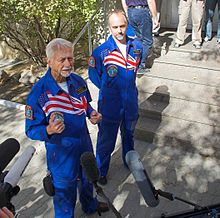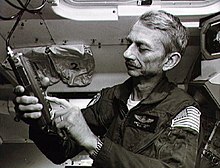
Skylab was the United States' first space station, launched by NASA, occupied for about 24 weeks between May 1973 and February 1974. It was operated by three trios of astronaut crews: Skylab 2, Skylab 3, and Skylab 4. Operations included an orbital workshop, a solar observatory, Earth observation and hundreds of experiments. Skylab's orbit eventually decayed and it disintegrated in the atmosphere on July 11, 1979, scattering debris across the Indian Ocean and Western Australia.

Alan LaVern Bean was an American naval officer and aviator, aeronautical engineer, test pilot, NASA astronaut and painter. He was selected to become an astronaut by NASA in 1963 as part of Astronaut Group 3, and was the fourth person to walk on the Moon.

Spacelab was a reusable laboratory developed by European Space Agency (ESA) and used on certain spaceflights flown by the Space Shuttle. The laboratory comprised multiple components, including a pressurized module, an unpressurized carrier, and other related hardware housed in the Shuttle's cargo bay. The components were arranged in various configurations to meet the needs of each spaceflight.

STS-9 was the ninth NASA Space Shuttle mission and the sixth mission of the Space Shuttle Columbia. Launched on 28 November 1983, the ten-day mission carried the first Spacelab laboratory module into orbit.

Richard Allen Garriott de Cayeux is a British-born American video game developer, entrepreneur and space tourist.

Henry Warren Hartsfield Jr. was a United States Air Force Colonel and NASA astronaut who logged over 480 hours in space. He was inducted into the United States Astronaut Hall of Fame in 2006.

Jack Robert Lousma is an American astronaut, aeronautical engineer, retired United States Marine Corps officer, former naval aviator, NASA astronaut, and politician. He was a member of the second crew, Skylab-3, on the Skylab space station in 1973. In 1982, he commanded STS-3, the third Space Shuttle mission. Lousma was inducted into the United States Astronaut Hall of Fame in 1997. He is the last living crew member of both of his spaceflights.

William Benjamin Lenoir was an American electrical engineer and NASA astronaut.
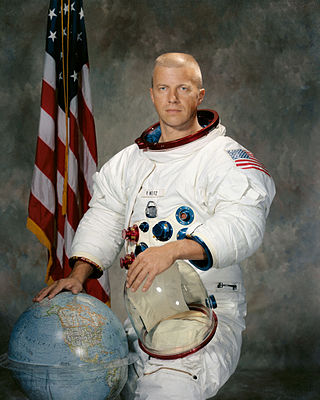
Paul Joseph Weitz was an American naval officer and aviator, aeronautical engineer, test pilot, and NASA astronaut, who flew into space twice. He was a member of the three-man crew who flew on Skylab 2, the first crewed Skylab mission. He was also commander of the STS-6 mission, the maiden flight of the Space Shuttle Challenger.

William Edgar Thornton was an American NASA astronaut. He received a Bachelor of Science degree in physics from University of North Carolina and a doctorate in medicine, also from UNC. He flew on Challenger twice, the STS-8 and STS-51-B missions.

Skylab 3 was the second crewed mission to the first American space station, Skylab. The mission began on July 28, 1973, with the launch of NASA astronauts Alan Bean, Owen Garriott, and Jack Lousma in the Apollo command and service module on the Saturn IB rocket, and lasted 59 days, 11 hours and 9 minutes. A total of 1,084.7 astronaut-utilization hours were tallied by the Skylab 3 crew performing scientific experiments in the areas of medical activities, solar observations, Earth resources, and other experiments.

Gerald Paul "Jerry" Carr was an American mechanical and aeronautical engineer, United States Marine Corps officer, naval aviator, and NASA astronaut. He was commander of Skylab 4, the third and final crewed visit to the Skylab Orbital Workshop, from November 16, 1973, to February 8, 1974.

Anthony Wayne "Tony" England is an American former NASA astronaut. Selected in 1967, England was among a group of astronauts who served as backups during the Apollo and Skylab programs. Like most others in his class, he flew during the Space Shuttle program, serving as a mission specialist on STS-51-F in 1985. He has logged more than 4,000 hours of flying time and 188 hours in space.

Edward George Gibson is a former NASA astronaut, pilot, engineer, and physicist.
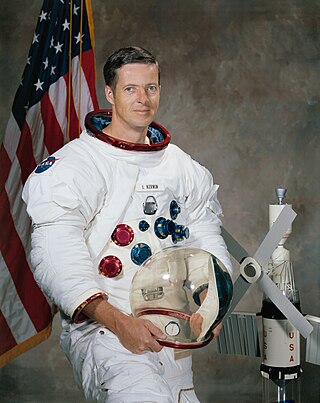
Joseph Peter Kerwin is an American physician and former NASA astronaut. He served as the science pilot for the Skylab 2 mission from May 25, 1973, to June 22, 1973. He was the first physician to be selected for astronaut training and the first doctor from the United States to enter space.

Don Leslie Lind was an American scientist, naval officer, aviator, and NASA astronaut. He graduated from the University of Utah with an undergraduate degree in physics in 1953. Following his military service obligation, he earned a PhD in high-energy nuclear physics from the University of California, Berkeley in 1964.
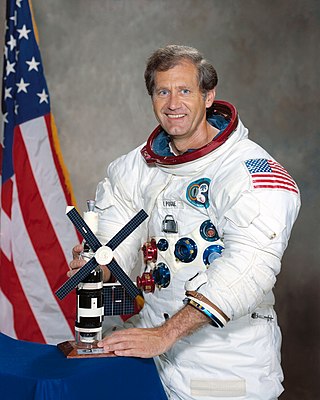
William Reid "Bill" Pogue was an American astronaut and pilot who served in the United States Air Force (USAF) as a fighter pilot and test pilot, and reached the rank of colonel. He was also a teacher, public speaker and author.

Skylab 4 was the third crewed Skylab mission and placed the third and final crew aboard the first American space station.

NASA Astronaut Group 4 was a group of six astronauts selected by NASA in June 1965. While the astronauts of the first two groups were required to have an undergraduate degree or the professional equivalent in engineering or the sciences, they were chosen for their experience as test pilots. Test pilot experience was waived as a requirement for the third group, and military jet fighter aircraft experience could be substituted. Group 4 was the first chosen on the basis of research and academic experience, with NASA providing pilot training as necessary. Initial screening of applicants was conducted by the National Academy of Sciences.

Soyuz TMA-12 was a Soyuz mission to the International Space Station (ISS) which was launched by a Soyuz FG rocket at 11:16 UTC on 8 April 2008. It docked to the Pirs module of the station on 10 April 2008. Landing occurred at 03:37 on 24 October. It was the first nominal landing in three missions, following separation failures on the Soyuz TMA-10 and 11 spacecraft.




